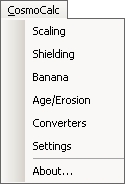


Next: Production rate scaling factors
Up: CosmoCalc: an Excel Add-In
Previous: CosmoCalc: an Excel Add-In
Introduction
The first applications of Terrestrial Cosmogenic Nuclide (TCN)
geochronology appeared about 20 years ago (Kurz, 1986; Nishiizumi et
al., 1986; Phillips et al., 1986). The method has rapidly developed
since those early days, truely revolutionizing geomorphology and
related fields in the process. TCN dating is no longer a specialized
tool used by a small group of experienced users, but has found an ever
growing base of users who are not necessarily familiar with all the
details of the method. Today we are facing a paradoxal situation. On
the one hand, a better understanding of cosmogenic nuclide production
systematics has improved the accuracy of TCN dating. But on the other
hand, many users of the method may be less familiar with its
intricacies than was the case in the pioneering days. An important
example of this situation is that of the production rate scaling
factors. In a landmark paper, Lal (1991) presented a method to
calculate cosmogenic nuclide production rates as a function of
latitude and elevation. Lal's scaling factors are elegant and easy to
use, but overestimate the importance of muons and are only valid for
standard atmosphere. Later authors introduced several improvements,
incorporating atmospheric effects and improved muon production
systematics. The scaling factors of Stone (2000), Dunai (2000), and
Desilets et al. (2003, 2006) more accurately represent the scaling of
cosmogenic nuclide production rates with latitude and elevation, but
the increased sophistication of these methods is an obstacle to their
widespread use.
CosmoCalc is an add-in to MS-Excel developed with the intention to
alleviate this problem. The CosmoCalc interface was designed to be as
user friendly and easy-to-use as possible. Default parameters are set
so that beginning users only have to make a minimal number of
decisions. At the same time, all the default parameters can be changed
so that CosmoCalc is highly customizable and also experienced users
should find it useful. The program as well as a spreadsheet with test
data can be downloaded from the CosmoCalc website
(http://cosmocalc.googlepages.com), which also provides
detailed installation instructions. The add-in requires MS-Excel 2000
or higher. Because of small differences between the MS-Windows and
Apple OS-X implementations of Excel, two versions of CosmoCalc are
provided. The functionality of both programs is the same, but the
Macintosh version is significantly slower than the PC-version.
After installing the CosmoCalc add-in, a toolbar menu appears (Figure
1) that guides the user through the data reduction
and closely follows the outline of this paper:
- Production rate scaling factors (Section 2)
- Lal (1991)
- Stone (2000)
- Dunai (2000)
- Desilets and Zreda (2003)
- Desilets et al. (2006)
- Shielding corrections (Section 3)
- Topographic shielding
- Self shielding
- Snow shielding
- Banana plots (Section 4)
- Age/erosion rate calculations (Section 5)
- Single nuclide: exposure age and erosion rate calculations for
 Al,
Al,  Be,
Be,  Ne,
Ne,  He,
He,  Cl and
Cl and  C
C
- Two nuclides: simultaneous calculation of (burial or exposure)
age and erosion rate.
- Converters (Section 6)
- Convert elevation to atmospheric pressure or -depth and back,
under standard and Antarctic atmosphere.
- Convert geomagnetic latitude to -inclination or cutoff
rigidity and back.
- Settings: customizing CosmoCalc (Section 7)
- Specify TCN production rate calibration sites
- Specify the relative importance of various production pathways
The following sections will provide more details about these
calculations. Thus, the present paper serves as an abridged review of
TCN calculations, with an emphasis on the numerical methods that are
needed to solve the equations. More details about the physics of TCN
production are given in the review article of Gosse and Philips
(2001). CosmoCalc is not the first computational tool for TCN
calculations. Useful alternatives are CHLOE, an Excel spreadsheet for
cosmogenic  Cl calculations (Phillips and Plummer, 1996) and the
CRONUS-Earth web-calculator (Balco and Stone, 2007;
http://hess.ess.washington.edu/math). CosmoCalc was
developed independently from these other tools, except for its
topographic shielding correction function, which was translated into
VBA from the Matlab code of Balco and Stone (2007). The reader is
strongly encouraged to try these other programs. CosmoCalc is
optimized for
Cl calculations (Phillips and Plummer, 1996) and the
CRONUS-Earth web-calculator (Balco and Stone, 2007;
http://hess.ess.washington.edu/math). CosmoCalc was
developed independently from these other tools, except for its
topographic shielding correction function, which was translated into
VBA from the Matlab code of Balco and Stone (2007). The reader is
strongly encouraged to try these other programs. CosmoCalc is
optimized for  Al,
Al,  Be,
Be,  Ne and
Ne and  He dating.
Because geomagnetic field fluctuations and thermal neutron reactions
are ignored, results for
He dating.
Because geomagnetic field fluctuations and thermal neutron reactions
are ignored, results for  Cl and
Cl and  C may be inaccurate.
CosmoCalc can be used as an exploratory tool for these nuclides, but
for more accurate results, CHLOE or the spreadsheet of Lifton et al.
(2005) are recommended.
C may be inaccurate.
CosmoCalc can be used as an exploratory tool for these nuclides, but
for more accurate results, CHLOE or the spreadsheet of Lifton et al.
(2005) are recommended.
Figure 1:
CosmoCalc's main menu guides the user through
the data reduction and follows the outline of this paper.
|
|



Next: Production rate scaling factors
Up: CosmoCalc: an Excel Add-In
Previous: CosmoCalc: an Excel Add-In
Pieter Vermeesch
2007-06-16
 Al-
Al- Be
Be
 Ne-
Ne- Be
Be
 Al,
Al,  Be,
Be,  Ne,
Ne,  He,
He,  Cl and
Cl and  C
C
